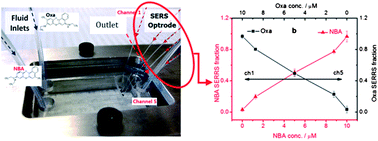Surface-enhanced Raman scattering (SERS) optrodes for multiplexed on-chip sensing of nile blue A and oxazine 720†
Abstract
The fabrication and on-chip integration of surface-enhanced Raman scattering (

* Corresponding authors
a
Department of Chemistry, University of Victoria, Victoria, BC V8W 3V6, Canada
E-mail:
agbrolo@uvic.ca
Fax: +1 250 721 7147
Tel: +1 250 721 7167
b Chengdu Green Energy and Green Manufacturing Technology R&D Centre, Chengdu, Sichuan, China
c Department of Mechanical Engineering, University of Victoria, Victoria, BC V8W 3P6, Canada
d Department of Mechanical and Industrial Engineering, University of Toronto, Toronto, ON, Canada
The fabrication and on-chip integration of surface-enhanced Raman scattering (

 Please wait while we load your content...
Something went wrong. Try again?
Please wait while we load your content...
Something went wrong. Try again?
M. Fan, P. Wang, C. Escobedo, D. Sinton and A. G. Brolo, Lab Chip, 2012, 12, 1554 DOI: 10.1039/C2LC20648J
To request permission to reproduce material from this article, please go to the Copyright Clearance Center request page.
If you are an author contributing to an RSC publication, you do not need to request permission provided correct acknowledgement is given.
If you are the author of this article, you do not need to request permission to reproduce figures and diagrams provided correct acknowledgement is given. If you want to reproduce the whole article in a third-party publication (excluding your thesis/dissertation for which permission is not required) please go to the Copyright Clearance Center request page.
Read more about how to correctly acknowledge RSC content.
 Fetching data from CrossRef.
Fetching data from CrossRef.
This may take some time to load.
Loading related content
